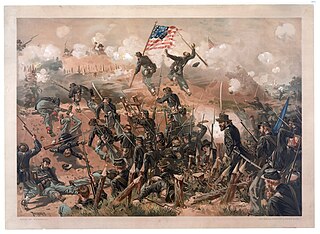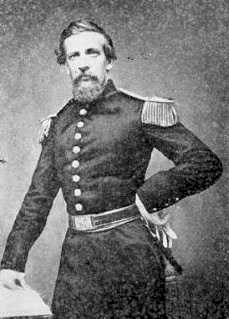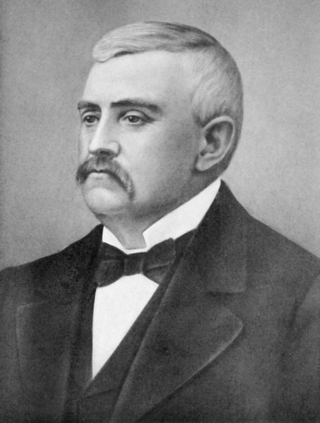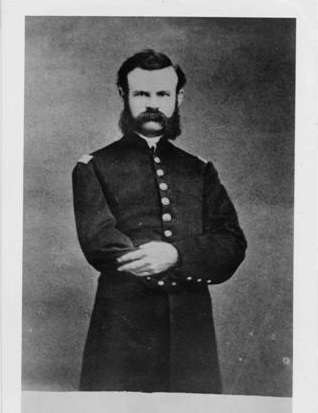
The siege of Vicksburg was the final major military action in the Vicksburg campaign of the American Civil War. In a series of maneuvers, Union Maj. Gen. Ulysses S. Grant and his Army of the Tennessee crossed the Mississippi River and drove the Confederate Army of Mississippi, led by Lt. Gen. John C. Pemberton, into the defensive lines surrounding the fortress city of Vicksburg, Mississippi.

The siege of Port Hudson, Louisiana, was the final engagement in the Union campaign to recapture the Mississippi River in the American Civil War.

The Second Battle of Corinth was fought October 3–4, 1862, in Corinth, Mississippi. For the second time in the Iuka-Corinth Campaign, Union Maj. Gen. William Rosecrans defeated a Confederate army, this time one under Maj. Gen. Earl Van Dorn.

John Stevens Bowen was a career United States Army officer who later became a general in the Confederate Army and a commander in the Western Theater of the American Civil War. He fought at the battles of Shiloh, Corinth, and the Vicksburg Campaign. He is often said to have died just as his abilities were gaining attention.

Daniel Ruggles was a Brigadier General in the Confederate States Army during the American Civil War. He was a division commander at the Battle of Shiloh.

John Creed Moore was a United States Army officer and a graduate of West Point. He is known for being a Confederate brigadier general during the Civil War and his works in the Texas educational system.
The 1st Missouri Infantry was an infantry regiment that served in the Confederate States Army during the American Civil War. Originally commanded by Colonel John S. Bowen, the regiment fought at the Battle of Shiloh, where it was engaged near the Peach Orchard on April 6, 1862. On April 7, during the Union counterattacks at Shiloh, the regiment was instrumental in preventing the Washington Artillery from being captured. The regiment was next engaged at the Second Battle of Corinth, where it outflanked several Union positions. On the second day at Corinth, the regiment was only minimally engaged. On November 7, the 1st Missouri Infantry was combined with the 4th Missouri Infantry to form the 1st and 4th Missouri Infantry (Consolidated), as a result of heavy battle losses in both regiments.

Lyman Munson Ward was an American farmer, Republican politician, and Union Army colonel in the American Civil War. He served four years in the Michigan House of Representatives, and received an honorary brevet to brigadier general after his service in the war.

The 9th Texas Infantry Regiment was a unit of Confederate States Army infantry volunteers organized in December 1861 that fought during the American Civil War. The regiment fought at Shiloh, Perryville, and Stones River in 1862, Chickamauga in 1863, the Atlanta Campaign, Allatoona, and Nashville in 1864, and Spanish Fort and Fort Blakeley in 1865. The remaining 87 officers and men surrendered to Federal forces in May 1865. Two of the regiment's commanding officers were promoted brigadier general.

The 32nd Texas Cavalry Regiment, sometimes incorrectly named Andrews's 15th Texas Cavalry Regiment, was a unit of volunteer cavalry mustered into the Confederate States Army in May 1862 and which fought during the American Civil War. The regiment was formed around companies from Richard Phillip Crump's 1st Texas Cavalry Battalion which fought in Indian Territory and at Pea Ridge. Many of the soldiers died of disease in the unhealthy camps near Corinth, Mississippi. The cavalrymen were dismounted in July 1862 and served as infantry for the rest of the war. The regiment fought at Richmond, Ky., Stones River, and Chickamauga in 1862–1863, in the Meridian and Atlanta campaigns and at Nashville in 1864, and at Spanish Fort and Fort Blakeley in 1865. The regiment's 58 surviving members surrendered to Federal forces on 9 May 1865.

The 3rd Louisiana Infantry Regiment was a unit of foot soldiers from Louisiana that fought in the Confederate States Army during the American Civil War. The regiment distinguished itself at Wilson's Creek in 1861. The 3rd Louisiana fought at Pea Ridge, First Corinth, Iuka, and Second Corinth in 1862. The unit defended Vicksburg in 1863 where it was captured. At Vicksburg, the unit's fortification was twice blown up by powerful land mines. The surviving soldiers were paroled and exchanged, after which they performed guard duty for the rest of the war.

The 6th Texas Cavalry Regiment was a unit of mounted volunteers that fought in the Confederate States Army during the American Civil War. The regiment fought at Chustenahlah in 1861. The following year the unit fought at Pea Ridge, First Corinth, Second Corinth, Hatchie's Bridge, and Holly Springs. The 6th Texas Cavalry participated in the fighting at Thompson's Station in 1863, the Atlanta campaign, and the Franklin–Nashville Campaign in 1864. The regiment formally surrendered to Union forces in May 1865 and its remaining soldiers were paroled.
Wade's Battery was an artillery battery in the Confederate States Army during the American Civil War. The battery was mustered into Confederate service on December 28, 1861; many of the members of the battery had previously served in the Missouri State Guard. Assigned to the First Missouri Brigade, the battery saw action at the Battle of Pea Ridge and the Second Battle of Corinth in 1862. In 1863, the battery fought at the Battle of Grand Gulf, where Captain William Wade, first commander of the battery, was killed. The battery later saw action at the Battle of Champion Hill, Battle of Big Black River Bridge, and the Siege of Vicksburg. When the Confederates surrendered at the end of the Siege of Vicksburg, the men of the battery became prisoners of war. After a prisoner exchange, the men of the battery were combined with Landis's Battery and Guibor's Battery on October 3, 1863, and Wade's Battery ceased to exist as a separate unit.

The 6th Missouri Infantry was an infantry regiment of the Confederate States Army during the American Civil War. The regiment was formed on August 26, 1862, when two existing units were combined. Later that year, the regiment was then lightly engaged at the Battle of Iuka and saw heavy action at the Second Battle of Corinth. In 1863, the regiment was engaged at the Battle of Port Gibson, and was part of a major charge at the Battle of Champion Hill. After a defeat at the Battle of Big Black River Bridge, the regiment took part in the siege of Vicksburg, where it saw heavy fighting. The siege of Vicksburg ended on July 4 with a Confederate surrender; after being exchanged, the regiment combined with the 2nd Missouri Infantry to form the 2nd and 6th Missouri Infantry (Consolidated). The 6th Missouri Infantry ceased to exist as a separate unit.
The 4th Missouri Infantry Regiment was formed on April 28, 1862, and served in the Confederate States Army during the American Civil War. The infantry regiment did not see action at the Battle of Farmington on May 9, and the Battle of Iuka on September 19 despite being part of the Confederate force present at those battles. As part of Brigadier General Martin E. Green's brigade, the regiment participated in three charges against Union lines on October 3, 1862, during the Second Battle of Corinth. The following day, the regiment, along with the rest of Green's brigade, attacked the new Union lines. Despite initial success, the attack was repulsed by a Union counterattack. The regiment ceased to exist as a separate unit when it was combined with the 1st Missouri Infantry Regiment on November 7, 1862, to form the 1st and 4th Missouri Infantry Regiment (Consolidated).
The 2nd Missouri Infantry Regiment was an infantry regiment that served in the Confederate States Army during the American Civil War. Organized on January 16, 1862, the regiment first saw major action at the Battle of Pea Ridge on March 7 and 8, 1862. After Pea Ridge, the regiment was transferred across the Mississippi River, fighting in the Battle of Farmington, Mississippi on May 9. The unit missed the Battle of Iuka in September, but was heavily engaged at the Second Battle of Corinth on October 3 and 4. The regiment helped drive in a Union position on October 3. On October 4, the 2nd Missouri Infantry, along with the rest of Colonel Elijah Gates' brigade, captured a fortification known as Battery Powell, but were forced to retreat by Union reinforcements.
The 3rd Missouri Infantry Regiment served in the Confederate States Army during the American Civil War. The infantry regiment was officially mustered into service on January 17, 1862. It fought at the Battle of Pea Ridge in Arkansas in March before being transferred across the Mississippi River. While stationed at Corinth, Mississippi, the regiment played a minor role in the Battle of Farmington before the evacuation of the town. In September, the unit saw light action at the Battle of Iuka before being heavily engaged during the Second Battle of Corinth as the Confederates attempted to retake the town in October. In early 1863, the regiment was transferred to Grand Gulf, Mississippi, in order to strengthen the defenses of the Mississippi River at that point. At the Battle of Grand Gulf on April 29, the unit helped repulse a Union Navy attack against the Confederate defensive works. After elements of the Union Army of the Tennessee landed below Grand Gulf, the regiment fought in a delaying action at the Battle of Port Gibson on May 1.

The 5th Missouri Infantry Regiment was an infantry regiment that served in the Confederate States Army during the American Civil War. The regiment entered into service on September 1, 1862, when the elements of two preceding battalions were combined. Many of the men entering the regiment had seen service with the secessionist Missouri State Guard. James McCown was the regiment's first colonel. After playing a minor role at the Battle of Iuka on September 19, the regiment then fought in the Second Battle of Corinth on October 3 and 4th. After being only lightly engaged on the 3rd, the regiment charged the Union lines on the 4th, capturing a fortification known as Battery Powell. However, Union reinforcements counterattacked and drove the regiment from the field. In early 1863, the regiment was transferred to Grand Gulf, Mississippi, where it built fortifications. The unit spent part of April operating in Louisiana, before again crossing the Mississippi River to return to Grand Gulf.

Battery F, 2nd Illinois Light Artillery Regiment was an artillery battery from Illinois that served in the Union Army during the American Civil War. The battery was organized in December 1861 at Cape Girardeau, Missouri. The unit fought at Shiloh, First Corinth, and Second Corinth in 1862 and at Vicksburg and Jackson in 1863. The battery served in the Atlanta campaign and at Nashville in 1864. It was mustered out of federal service in July 1865. The battery's first commander was John Wesley Powell who later led an exploration of the Grand Canyon.

The 24th and 25th Consolidated Texas Cavalry Regiment was a unit that originally consisted of two regiments of mounted volunteers that served in the Confederate States Army during the American Civil War. However, by the time the two regiments were consolidated, they fought as infantry. Both regiments organized as cavalry near Hempstead, Texas in April 1862 and were dismounted to fight as infantry in July 1862. The two regiments served in the same brigade and were captured at the Battle of Arkansas Post in January 1863. After being sent to Northern prison camps, the soldiers were exchanged in April 1863. Assigned to the Army of Tennessee, the two regiments were consolidated with two additional Texas cavalry regiments and in 1863 fought as infantry at Liberty Gap, Chickamauga, Missionary Ridge, and Ringgold Gap. In 1864, the other two Texas regiments were detached and the consolidated 24th and 25th fought as a separate infantry unit in the Atlanta campaign, at Franklin, and at Nashville. For the Carolinas campaign, the 24th and 25th fought at Bentonville before being reconsolidated with other Texas regiments and surrendering in April 1865.


















